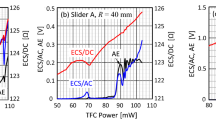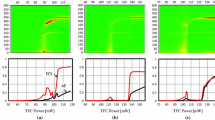Abstract
Different approaches to reduce the effect of short-range interactions on slider’s flying stability—reduction of pad width at trailing edge and increase of air pressure on trailing pad—are compared for the flying stability and flying height modulation. The static and dynamic simulations show both approaches can reduce the effect of intermolecular force and electrostatic force on the slider’s flying stability. On the other hand, the increase of air pressure on trailing pad can also reduce the flying height modulation caused by disk waviness, but reduction of pad width at trailing edge increases the flying height modulation. Hence, the increase of air pressure on trailing pad is more suitable for the application of the ultra low flying height in hard disk drives.











Similar content being viewed by others
References
Deoras SK, Talke FE (2000) Effect of intermolecular forces on the dynamic response of a slider. J Tribol 129(1):177–180. doi:10.1115/1.2390720
Lee S, Polycarpou A (2004) Adhesion forces for sub-10 nm flying-height magnetic storage head disk interfaces. J Tribol 126(2):334–341. doi:10.1115/1.1645299
Li H, Liu B, Hua W et al (2005) Intermolecular force, surface roughness, and stability of head-disk interface. J Appl Phys 97(10):10P305
Liu B, Yu SK, Zhang MS et al (2007) Air-bearing design towards highly stable head-disk interface at ultra low flying height. IEEE Trans Magn 43(2):715–720. doi:10.1109/TMAG.2006.888366
Thornton BH, Nayak A, Bogy DB (2002) Flying height modulation due to disk waviness of sub-5 nm flying height air bearing sliders. J Tribol 124:762–770. doi:10.1115/1.1479699
Wei P, Crone RM, Jones PM, Hsia YT (2006) Effect of van der Waals force on air-bearing flying characteristics at ultra-low fly height. IEEE Trans Magn 42(10):2483–2485. doi:10.1109/TMAG.2006.878615
Wood R (2000) The feasibility of magnetic recording at 1 terabit per square inch. IEEE Trans Magn 36:36–42. doi:10.1109/20.824422
Wu L, Bogy DB (2002) Effect of the intermolecular forces on the flying attitude of sub-5 NM flying height air bearing sliders in hard disk drives. J Tribol 124:562–567. doi:10.1115/1.1456454
Zhang B, Nakajima A (2003) Possibility of surface force effect in slider air bearings of 100 Gbit/in2 hard disks. Tribol Int 36:291–296. doi:10.1016/S0301-679X(02)00200-1
Author information
Authors and Affiliations
Corresponding author
Rights and permissions
About this article
Cite this article
Zhang, M., Liu, B. & Tjiptoharsono, F. Approaches to reduce effect of short-range interactions in head disk interface. Microsyst Technol 15, 1591–1595 (2009). https://doi.org/10.1007/s00542-009-0809-2
Received:
Accepted:
Published:
Issue Date:
DOI: https://doi.org/10.1007/s00542-009-0809-2




